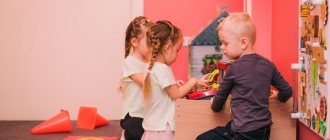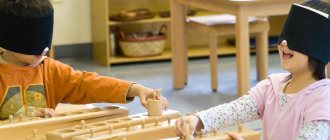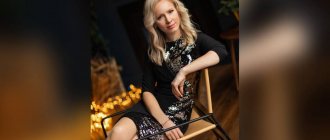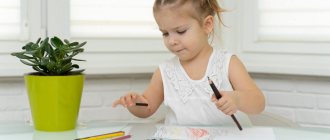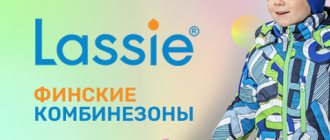Sensory abilities are manifested in a particularly sensitive perception of the properties and relationships of objects and phenomena in the surrounding world. Actions aimed at the perception and cognition of various objects can provide both superficial information and can reveal multifaceted knowledge about the properties and connections of these objects. It all depends on the abilities of the perceiver.
The sensory abilities of preschoolers are at the initial stage, as, in fact, is all mental development at this age. It is important to stimulate the formation of these abilities in order to provide the child with full-fledged conditions for entering the real world.
Features of the formation of children's sensory abilities
The development of a child’s perception, in essence, is a process of formation and improvement of perceptual actions. In childhood, perceptual actions are the main providers of information that help the child navigate a multifaceted and still completely unknown environment. That’s why children want to touch and even taste everything.
Sensory abilities are part of cognitive abilities. The preschooler is extremely inquisitive, and he acts as much as his physical capabilities allow.
Practice puts forward specific tasks for the child’s perception - observing, lifting, pulling through a hole, matching by color, hearing a certain sound and similar exercises, the implementation of which occurs thanks to the sensory functions of the body.
Even when a child acts spontaneously, without any outside promptings, he not only accumulates experience in perceptual operations, but also draws certain conclusions. For example, a tomato is similar to an apple, but its taste is different; the ball fits into one bucket, but not into the other; For some reason mom’s bag won’t lift...
The baby needs certain basic information that would serve as a measure for new information coming to him. And this perceptual base is slowly accumulating. It has its own scientific name - sensory standards. Of course, they are not “implanted” in the child’s brain overnight. Standards are gradually collected in the treasury of children's consciousness, going through the natural path of formatting. The more standards (measures, samples) are fixed in the cognitive experience of a preschooler, the easier it will be for him to assimilate new information.
Sensory standards in preschool age
Standards of perception, before becoming established and acquiring clear boundaries, pass through the stage of pre-standards in childhood development.
It is impossible to list all sensory standards; let us note some of the most important of them:
- forms
- colors
- size
- volume
- smoothness
- hardness
- distances, etc.
The formation of each standard requires its own time interval. For example, how does a child perceive color? The first ones he begins to highlight are red, yellow, and green. Shades are not yet differentiated by the child’s visual perception.
For example, a younger preschooler perceives cherry and pink as red. Only after a certain time, after adults several times show the child objects of the corresponding color (cherry, bow, cherry-colored socks), this shade in the child’s understanding will first stand out as different from red, and then be remembered by its name.
The main condition for the formation of sensory reference representations in preschool age is the ability to conduct a perceptual examination by the child of those properties of objects that should become reference.
That is, a preschooler must examine or turn an object in his hands in order to understand its shape; touch or squeeze several toys to feel hardness or elasticity, listen to similar sounds to highlight sonority, etc.
It is especially difficult to form such a sensory standard as quantity. If a child looks at objects in reality, then already at 3 years old he will determine which one is large and which one is small. But, if a preschooler looks at the images, it is difficult for him to understand which object is larger.
Test. To check at what stage of formation the pre-standard value is, show the preschooler a drawing that shows a one-story house in the foreground, and a multi-story house in the distance.
Ask your child which of these houses is bigger. If a child points to a smaller image and explains that this house is larger because it has floors, it means that he is already taking perspective into account in his perception of size. This indicates the formation of this sensory standard. If the answer is different, children are guided by absolute sizes, which corresponds to the initial stage of the formation of the perception of size.
Of course, children with pronounced sensory abilities will quickly master spatial orientation. Already at 4-5 years old they adequately assess the real shape and size of images. And other sensory standards will take their full place in the perception of a capable child earlier than in other children.
Sensory development is the foundation of the mental development of preschool children
One of the tasks of a child’s mental education is the formation of a system of elementary knowledge about objects and phenomena of the surrounding life.
Cognition begins with sensory acquaintance with objects and phenomena of the surrounding world, with sensations and perceptions. The first source of knowledge about the world is sensations. With the help of sensations, the child learns individual signs and properties of objects that directly affect his senses. This is how the baby learns that objects have their own taste, color, size, smell, sound, weight, temperature, etc. A more complex cognitive process is perception, which ensures the reflection of all (many) signs of an object with which the child is in direct contact.
In life, a child encounters a variety of shapes, colors and other properties of objects, in particular toys and household items. He also gets acquainted with works of art: music, painting, sculpture. The baby is surrounded by nature with all its sensory signs - colors, smells, noises. And of course, every child, even without targeted upbringing, perceives all this in one way or another. But if assimilation occurs spontaneously, without competent pedagogical guidance from adults, it often turns out to be superficial and incomplete. Sensations and perceptions can be developed and improved, especially during preschool childhood. And this is where sensory education comes to the rescue.
Sensory development has always been and remains important and necessary for the full upbringing of children. Child sensory development
- this is the development of his perception and the formation of ideas about the most important properties of objects, their shape, color, size, position in space, as well as smell and taste. The importance of sensory development in early preschool age is difficult to overestimate. It is this period that is most favorable for improving the functioning of the senses and accumulating ideas about the world around us. This is the gradual assimilation of the sensory culture created by humanity.
Sensory development is a condition for successful mastery of any practical activity, and the origins of abilities lie in the general level of sensory development achieved in early preschool age. The period of the first 3 years is the period of the most intensive physical and mental development of children. Sensory development is aimed at teaching children to accurately and accurately perceive objects, their various properties and relationships (color, shape, size, pitch of sounds, etc.). Psychological research shows that without such training, children’s perception for a long time remains superficial, fragmentary and does not create the necessary basis for general mental development, mastery of various types of activities (drawing, design, speech development, etc.) and the full assimilation of knowledge and skills.
At each age, sensory education has its own tasks, and a certain element of sensory culture is formed.
— In the first year of life
The main task is to present the child with sufficient richness and variety of external impressions and to develop attention to the properties of objects. Sensory education during this period is the main type of education in general. Providing an influx of ever new impressions, it becomes necessary not only for the development of the activity of the senses, but also for the normal general physical and mental development of the child.
— In the second or third year of life
the task of sensory education becomes significantly more complicated. The child begins to accumulate ideas about color, shape, size and other properties of objects. It is important that these representations be sufficiently diverse. This means that the child should be introduced to all the main types of properties - the six colors of the spectrum (blue, purple, red, orange, yellow, green), such shapes as circle, oval, square, rectangle.
— From three years old
The main place in the sensory education of children is to familiarize them with generally accepted sensory standards and ways of using them. This is color, shades of color tones, geometric shapes, sizes.
In the first year of a child’s life, the tasks of sensory education are successfully solved in manipulative and objective activities. In the future, the richest possibilities for sensory development are hidden in such types of activities as play, work, constructive, and visual arts. Each of these activities has its own sensory basis. In visual activity, this is the perception and discrimination of color, shades, shape, size, spatial arrangement, proportions; in work activity - perception and discrimination of the characteristics of materials, their plasticity, texture, pressure properties, etc.
Improving any activity depends on the level of sensory development of the child. This dependence can be seen especially clearly in artistic activities, which require the predominant development of certain analyzers that provide the necessary accuracy and subtlety of differentiation.
Speech plays a great role in the development of sensory cognition. The adult’s word captures the sensory experience acquired by the child and generalizes it: “This is a ball. It's round, it rolls." As the child masters speech, his sensations acquire a new quality: the word helps to isolate a new feature and see it in other objects. Introducing the names of various characteristics into the child’s vocabulary (sour, sweet, warm, cold, transparent, red, shiny, matte, etc.) helps develop the ability to compare - the most important mental operation. Verbal designations of the signs and properties of objects contribute to their meaningful perception and clear distinction.
The significance of sensory development is that it organizes the child’s chaotic ideas obtained during interaction with the outside world, develops attention, develops observation, is the basis for intellectual development, and ensures the assimilation of sensory standards.
Sensory standards
— this is generalized sensory knowledge, sensory experience accumulated by humanity over the entire history of its development.
The external qualities and properties of objects in the surrounding world are extremely diverse. In the course of historical practice, systems of those sensory qualities that are most significant for a particular activity have been identified: systems of measures of weight, length, directions, geometric shapes, color, size; norms of sound pronunciation, system of sounds in height, etc.
In the early years
During the life of children, the prerequisites for sensory standards are formed.
From the second half of the first year to the beginning of the third year, so-called sensorimotor prestandards
. During this period, the baby displays individual properties of objects that are essential for his movements (certain features of the shape, size of objects, distance, etc.).
In preschool age
the child uses so-called
object standards
: he correlates images of the properties of objects with certain objects (he calls orange “like a carrot”, green - “like grass”; he defines a square through the shape of a pocket or handkerchief). Usually this period lasts until the border between the fifth and sixth years of life, but it can be delayed if adults “implant” subject standards into the child’s activities.
In older preschool age
children can correlate the qualities of objects with mastered generally accepted standards: the sun is like a ball, a lemon and an oval-shaped cucumber. For a child of this age, the color standard is the seven colors of the spectrum: red, orange, yellow, green, blue, indigo, violet, and their shades; as standards of form - a system of geometric figures, for auditory perception - the “phoneme grid” of the native language, the pitch scale of musical sounds (do, re, mi, fa, sol, la, si), etc.
The content of sensory education includes a wide range of signs and properties of objects that a child must comprehend throughout preschool childhood. Traditional content has developed in sensory education. This is an acquaintance with color, size, shape, taste, smell, texture, heaviness, sound of objects in the surrounding world, and orientation in space. In this case, the task is to increase the sensitivity of the corresponding analyzers (development of tactile, visual, olfactory, auditory sensitivity, etc.), which manifests itself in distinguishing signs and properties. At the same time, the child learns to correctly name the properties of objects (soft-hard, cold-warm, hot, bitter-sweet, light-hard, bottom-top, right-left, far-close).
In the domestic system of sensory education, the traditional content is expanded and supplemented by including time orientation, development of speech and musical hearing.
Orientation in time
assumes that the child acquires ideas about parts of the day, days of the week, months, year, and the fluidity of time (it cannot be stopped, returned, or accelerated; it does not depend on the person).
Speech (phonemic) hearing
- this is the ability to perceive speech sounds, differentiate and generalize them in words as meaningful units. The development of phonemic hearing is associated with mastery of sound pronunciation norms.
Ear for music
- this is the ability to distinguish sounds by pitch, timbre, rhythmic pattern, melody.
The methodology of sensory education involves teaching children to examine objects and forming ideas about sensory standards.
Inspection training is carried out as a specially organized perception of an object in order to identify those of its properties that are important to know about in order to successfully cope with the upcoming activity. The same subject is examined in different ways depending on the purpose of the examination and the qualities being examined.
There are rules for examining objects: perception of the holistic appearance of the object; mental division into main parts and identification of their characteristics (shape, size, color, material, etc.); spatial correlation of parts with each other (left, right, above, top, etc.); isolating small parts, establishing their spatial location in relation to the main parts; repeated holistic perception of the subject.
An examination according to this scheme will help children master generalized methods of sensory cognition, which they can use in independent activities.
Throughout preschool childhood, the nature of sensory cognition changes: from manipulating objects, the child gradually moves to becoming familiar with them on the basis of vision, touch, and “visual palpation.” For example, in order to make sure that there is raw sand in the bucket, the baby must touch it, but a child of 5–6 years old only needs to look.
The teacher must create conditions for preschoolers to apply their acquired knowledge and skills to analyze the environment. For example, older children are involved in repairing books and board game boxes, and they determine what paper to take (thin, thick, transparent), what length and width to cut the strips. Children of early and early preschool age are offered toys that develop their sensations and perceptions. These are dismountable toys, inserts, as well as toys made from different materials, differing in size and sound.
Didactic games are used to enrich children's sensory experience. Many of them are related to the examination of an object, to distinguishing features, and require verbal designation of these features (“Wonderful bag.” “How they are similar and not similar,” etc.). in some games, the child learns to group objects according to one quality or another (puts round toys in a box, collects red mushrooms in a red bucket, etc.). children compare objects with similar and different characteristics and identify the most significant ones. As a result, it becomes possible to lead children to generalizations based on identifying essential features that are fixed in speech. Thus, children fail to master sensory standards.
Nature plays a special role in the sensory education of children. Cognition of the natural environment is initially carried out through the senses, using vision, hearing, touch, and smell. For example, in the forest, in the park, children learn to distinguish the color of autumn foliage: birch is lemon-colored, oak is brown, aspen is red or purple. The picture of an autumn forest is perceived brighter if the teacher offers to listen to the voices of birds, the sound of the wind, the rustle of falling leaves; teaches you to identify the smells of mushrooms and rotten greens. The more sense organs are “involved” in cognition, the more signs and properties the child identifies in the object or phenomenon under study, and therefore, the richer his ideas become. On the basis of such ideas, thought processes and imagination arise, and aesthetic feelings are formed.
The success of mental, physical, and aesthetic education largely depends on how perfectly the child hears, sees, and touches the environment.
Knowledge begins with the perception of objects and phenomena of the surrounding world. All other forms of cognition - memorization, thinking, imagination - are built on the basis of images of perception and are the result of their processing. Therefore, normal intellectual development is impossible without relying on full perception.
Literature:
1. Zhukova O. S. et al. Encyclopedia of development and training of preschool children / O. S. Zhukova, A. S. Gerasimova, V. G. Kuznetsova. - St. Petersburg: Publishing House "Neva", 2005. - 352 p. — (Series “Program for the development and training of preschoolers”).
2. Kozlova S. A. Preschool pedagogy: A textbook for students. avg. prof. textbook institutions / S. A. Kozlova, T. A. Kulikova. — 6th ed., rev. - M.: Publishing House, 2006. - 416 p.
3. Yakobson S.G. Preschooler. Psychology and pedagogy of age: a methodological manual for kindergarten teachers / S. G. Yakobson, E. V. Solovyova. - M.: Bustard, 2006. - 176 p. — (Preschooler. Psychology).
4. https://sensoricinru.wordpress.com/2013/02/11/nurturing-sensory-skills-early/
5. https://www.moi-detsad.ru/konsultac288.html
Development of sensory abilities in the activities of preschool children
Productive activities provide favorable conditions for the development of sensory abilities in preschool childhood. Drawing, designing, modeling, making appliques - all these activities help the child not only notice certain properties and relationships of objects, but also provide the opportunity to apply and feel them through the materials used.
It is important not so much to master a sensory standard as to learn to relate it, as a measure, to a specific object or phenomenon in different conditions.
Where else can one acquire information about shape and size if not in constructive activities? A preschooler builds towers and bridges, trying on parts of construction sets; assembles puzzles, looking for suitable protrusions and holes; tightens nuts, connecting parts of metal and wooden construction sets. Only in such real practice do sensory abilities associated with visual and tactile receptors develop.
Sensory development of a preschooler: essence, tasks, exercises
The sensory development of preschoolers is one of the most important points in the full and high-quality education of a child. Many parents do not attach much importance to targeted sensory activities, believing that the knowledge of the world, objects and forms in a child of primary preschool age will occur naturally and naturally.
Some even believe that classes are harmful, as they impose stereotypes and distort individuality. However, professional teachers refute this opinion, citing indisputable evidence of the need and effectiveness of consistent and thoughtful activities aimed at sensory education of preschoolers.
The simplest exercises for sensory development of children under three years old
At this age, the baby still does not know how to analyze - and he shouldn’t. A child’s development is considered normal if he is able to distinguish the color, size and configuration of objects, give the simplest qualitative and quantitative definitions - “soft”, “hard”, “many”, “few”, etc. The little ones are happy to participate in the game-activity.
But since children of this age need to keep their attention on the same object or process for a long time, classes should not last more than 10-15 minutes. If the child is of a phlegmatic nature, slow and serious, 5-7 minutes may be enough for him. After a while, you can conduct another lesson, alternating topics.
- Pyramids and cubes. There are several options here:
- for color - the baby must choose objects of the same color;
- on the mold - separate the balls from the cubes;
- for size - fold the pyramid from the smaller cone to the larger one and vice versa.
- Imitation. Kids love to copy adults and make faces. Show him a smile and comment - cheerful, kind. Then frown and comment again - angry, dissatisfied. Let the child repeat all your grimaces.
- Guess the fruits and vegetables. In an opaque bag or bag you need to put a set of vegetables and fruits that are well known to the child: potatoes, carrots, cucumbers, apples, oranges, etc. The task is to guess a vegetable or fruit by touch and describe its taste or quality. For example, an apple is hard, red, sweet, a lemon is rough, sour, a carrot is long, crispy. For older children, you can complicate the game - guess with your eyes closed by touch who gave him the hand (mom, dad, brother, grandmother, grandfather).
Playing outdoors with sand, pebbles, water, and plants is very useful.
Rules for organizing sensory education according to Montessori
Maria Montessori noticed that at a certain age, children's behavior and motivation are very similar. For example, in the first three years a child is especially sensitive to order. This childish “pedantry” is necessary for the child to create a stable image of this world. It can also be used to develop a child’s natural need for knowledge by creating tasks that are exciting for a certain age, which would help the child master the most important qualities of objects: color, size, shape, material.
As Maria Montessori herself admitted, the work of creating the sets was not easy: it was necessary to create material that would demonstrate properties in isolation, have pedagogical value, and at the same time be attractive to the child. This is how a set of Montessori sensory material appeared.
The main objectives of Montessori sensory exercises
- Teach the baby to perceive, compare and classify sensory experiences of different modalities,
- Expand the child’s sensory experience, teach him to notice even small differences, develop the child’s senses as much as possible,
- Teach your child to use his own memory: “I remember what yellow is, and I can always imagine it in my head,”
- Teach to critically evaluate any information and develop the habit of striving for maximum accuracy when gaining knowledge about the world,
- Create a basis for the emergence of abstract thinking and imagination.
Let us explain with an example how sensory and abstract thinking are connected:
Let's say you've never seen an okapi. Now your task is to imagine this animal by description: it is a bay horse with the legs of a zebra and the head of a giraffe. Happened? If so, congratulations, your sensory development is on point, because for this exercise you need to have an understanding of the colors of horses, the coloring of a zebra and the body structure of a giraffe.
Any abstract idea is essentially a clever interweaving of various information from our real experience. That is why a child’s intelligence begins in early childhood and the ability to exercise all the senses over and over again.
What can you find in the sensory development area of the Montessori center?
Visual information
- Shapes: sets of geometric shapes, as well as more complex shapes (for example, animal figures or plant leaves)
- Volumetric figures: Pink Tower, Brown staircase, Red barbells, Montessori weight cylinders
- Colors: sets of basic colors, card index of shades
Tactile information
- Texture: palpable board, rough tablets, baskets with rags
- Temperature: heat jugs, heat plates
- Weight: weighing cylinders and plates
Stereognostics
- Sorting small items, magic bag
Audio information
- Volume: sound boxes, musical accompaniment of classes
- Height: bells, sound cylinders, musical instruments
Taste and smell
- Taste bottles, conversations during meals
- Jars with scents
In addition to exercises with isolated sensory qualities, in a Montessori space you can always find sets that combine several qualities, such as color and shape:
- Binomial cube
- Trinomial cube
- Constructive triangles
- Montessori squares
- Cylinders without handle
The study of sciences according to M. Montessori also begins with sensory education. Acquaintance with the basic qualities of objects of the natural and cultural world prepares the child for studying social sciences, biology, physics, chemistry and even mathematics:
- Sets of leaves of different plants
- Thematic puzzles
- Maps and globe
- Flags
- Sets with natural materials
- Reproductions of artists and nature photographs
Senior preschoolers (6–7 years old)
6-7 years is a period when sensory development gains momentum with renewed vigor.
How does this happen? The child becomes more attentive.
He can already control his attention and gaze.
For example, if the attention period of a 4-5 year old child is about 6 minutes, then at 6-7 years old this period will be 10-12 minutes.
But at the same time, such children are not yet able to penetrate into the essence of things; they are still focused on the form.
Another feature of this age is the lack of differentiation of perception. The child sees only superficial information and does not yet know how to penetrate into the essence of things. This is well demonstrated by simple experience. In front of a group of children they placed 2 rows of buttons of the same size, in one row there were seven buttons, in the other 10. In the row where there were 7 buttons, under each of them they placed another one of the same size and shape. Then they asked the kids: “Which row has more buttons?” Almost all children pointed to a row of 10 buttons, since it was visually longer.
In addition, children 6-7 often confuse words that are similar in spelling and sound, but completely different in meaning, for example, “put” and “set up.” This is due to the fact that during this period their analytical function is poorly developed and it is difficult for children to analyze and perceive purposefully and in depth. The visual component still remains a priority at this stage.
As for the perception of time and space, it has its own characteristics in children of this age. They have difficulty processing large periods of time. For example, the period of dinosaurs and 80 years will be perceived by them in exactly the same way, because children do not yet have temporal abstraction.
Attention! At this stage, it is very important for the teacher to teach children to correctly perceive and evaluate spatial and temporal categories and meanings.
Card index of didactic games on sensory education for young children 2-3 years old
Didactic material for sensory education - systematized sets of objects or pictures that give children the opportunity to practice identifying certain characteristics of objects, comparing some objects with others, grouping objects, and solving problems on their spatial arrangement. As cognitive abilities develop, the material becomes more complex.
Learning takes place in a playful way so that preschoolers remain highly motivated to study.
Requirements for educational games:
- safety;
- visibility;
- naturalness of materials;
- brightness and naturalness of colors;
- availability;
- age appropriate.
